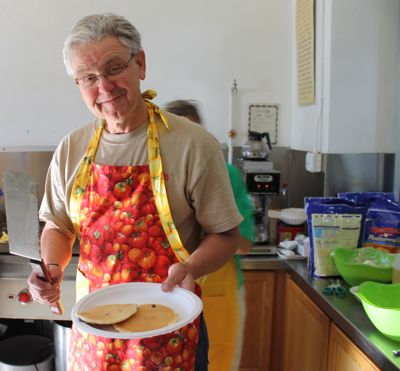
Not since Mary Kay Letourneau titillated the tabloids with details of her ongoing romantic involvement with a teenage boy has the greater West Seattle area produced an internationally notorious celebrity like Amanda Knox. Knox grew up in the Arbor Heights neighborhood just west of White Center. Some of her family are familiar to us at the cafe, so writing about her case, a case which has drawn such notoriety, is necessarily fraught with emotion. It seems, the whole world is riveted on the trial of Knox and her former lover and codefendant, the Italian national, Raffaele Sollecito. The case has riveted both the English and Italian press and has spawned a cottage industry in the blogosphere.
In addition to the media attention, the case has produced two warring camps: those who proclaim Knox’s innocence and those who profess her guilt. The Knox family is receiving the services of a prominent Seattle attorney to discount the prosecution’s case. The attorney, Anne Bremner, has put forward her own theory of the case, of which more later. As is often the case with public relations campaigns, though, these efforts have produced more heat than light. It is perfectly understandable that the family would wage a vigorous campaign on behalf of their daughter. Blood ties.
For those very few people unfamiliar with the details of the crime, it took place in the picturesque town of Perugia, Italy. Perugia has a large population of foreign students and it is where Knox and Meredith Kercher, of Couldson, England went to study abroad. Knox, Kercher, and two other women were flatmates. On November 2, 2007, at approximately 1 p.m. the body of Meredith Kercher was found in her room. Her throat had been cut in a brutal manner. Her eyes were turned to the left and fixed in a rigid gaze, her tongue bone broken, and her neck bisected by a long, deep gash. Medical examiners say she died a slow and painful death. She had, as well, been sexually assaulted. Der Spiegel
Although Knox and Sollecito were first on the scene following the crime, it was not they who called the police. (A neighbor had found Kercher’s mobile phone under a tree and contacted the police.) By the time officers rang the doorbell at 12:35 p.m., on November 2nd, Knox had already notified another roommate and two friends. The two other women living in the apartment had gone away on holiday, so the door to Kercher’s room was broken down at this point.
When investigators arrived on the scene they were surprised to find that all of the rooms, except for Kercher’s, had apparently been scrubbed with concentrated cleaning agent, believed to be bleach, after the murder. They were even more surprised to find that none of Knox’s fingerprints could be found in the apartment, despite the fact that she lived there. Der Spiegel Police state that they detected the odor of bleach on Nov. 6, 2007 — the day both defendants were arrested. The allegation is that the defendants might have used bleach to eliminate possible traces on any item that might tie them to the crime.

Both, Amanda Knox and Raffaelle Sollecito maintain their innocence. A third individual, Rudy Guede, and African immigrant, opted for a separate “quick trial” and was convicted of murder. He was sentenced to 30 years in prison.
On November 6, Italian police arrested Knox, then 20, Sollecito, 23, and Congolese national Diya “Patrick” Lumumba, 38. (Lumumba owned a local bar that occasionally employed Knox as a barmaid; his arrest resulted from Knox’s claim that she saw him enter Kercher’s room and heard screams emanating from it.) In their statement, the police said Kercher was murdered because she refused to take part in violent sex. According to Knox’s statement:
“I want to tell you what happened because it’s left me really shocked and I’m terrified of Patrick, the African boy who owns the Le Chic pub where I work sometimes. I saw him on the evening of 1 November, after I replied ‘see you’ to his text message. We met at about 9 p.m. on the basketball court in Piazza Grimana and went to my place. I can’t remember if Meredith was already there or if she turned up later. What I can say is that they went into the bedroom.” Amanda goes on to describe the assault in detail. Then she adds, “I met Patrick this morning [5 November – Ed.] outside the University for Foreigners and he asked me questions. He wanted to know what questions the police had asked me. I think he also asked me if I wanted to speak to journalists, perhaps because he was trying to find out if I knew anything about Meredith’s death”. (Emphasis added—Ed.)
As it happens, Lumumba had an airtight alibi and was eventually cleared as a suspect and released. Knox never provided a good explanation as to why she had accused Lumumba of the crime. Nor, despite the torrent of commentary, does anyone pick up on the very politically incorrect reference to the 38-year-old Lumumba as “the African boy.” Although from here on out, the alibis and stories of Knox and Sollecito become ever more contradictory. Knox has claimed the these contradictory statements were the results of drugs, exhaustion and police pressure as well as psychological stress.

Initially, both Knox and Sollecito had claimed to have been at Sollecito’s apartment on the night of the crime, although each noted that either one could have snuck out at night while the other was asleep.
Both of them had turned off their cell phones that night. Sollecito claimed that he was downloading a cartoon during the critical two hours that the crime occurred; however, tests indicated no activity on the computer that night and his Internet service provider indicated that there was no activity on his account that night. A surveillance camera, across the street from the flat, caught an image of Knox going to the house that night just before the murder. Knox retracted her initial alibi and gave a more detailed statement, which contradicted her first one.
Transcript of Amanda Knox’s handwritten statement to police on the evening of November 6, the day she was arrested:
This is very strange, I know, but really what happened is as confusing to me as it is to everyone else. I have been told there is hard evidence saying that I was at the place of the murder of my friend when it happened. This, I want to confirm, is something that to me, if asked a few days ago, would be impossible.
I know that Raffaele [Sollecito] has placed evidence against me, saying that I was not with him on the night of Meredith’s murder, but let me tell you this. In my mind there are things I remember and things that are confused. My account of this story goes as follows, despite the evidence stacked against me:
On Thursday November 1 I saw Meredith the last time at my house when she left around 3 or 4 in the afternoon. Raffaele was with me at the time. We, Raffaele and I, stayed at my house for a little while longer and around 5 in the evening we left to watch the movie Amelie at his house. After the movie I received a message from Patrik [sic], for whom I work at the pub “Le Chic”. He told me in this message that it wasn’t necessary for me to come into work for the evening because there was no one at my work.
Now I remember to have also replied with the message: “See you later. Have a good evening!” and this for me does not mean that I wanted to meet him immediately. In particular because I said: “Good evening!” What happened after I know does not match up with what Raffaele was saying, but this is what I remember. I told Raffaele that I didn’t have to work and that I could remain at home for the evening. After that I believe we relaxed in his room together, perhaps I checked my email. Perhaps I read or studied or perhaps I made love to Raffaele. In fact, I think I did make love with him.
However, I admit that this period of time is rather strange because I am not quite sure. I smoked marijuana with him and I might even have fallen asleep. These things I am not sure about and I know they are important to the case and to help myself, but in reality, I don’t think I did much. One thing I do remember is that I took a shower with Raffaele and this might explain how we passed the time. In truth, I do not remember exactly what day it was, but I do remember that we had a shower and we washed ourselves for a long time. He cleaned my ears, he dried and combed my hair.
One of the things I am sure that definitely happened the night on which Meredith was murdered was that Raffaele and I ate fairly late, I think around 11 in the evening, although I can’t be sure because I didn’t look at the clock. After dinner I noticed there was blood on Raffaele’s hand, but I was under the impression that it was blood from the fish. After we ate Raffaele washed the dishes but the pipes under his sink broke and water flooded the floor. But because he didn’t have a mop I said we could clean it up tomorrow because we (Meredith, Laura, Filomena and I) have a mop at home. I remember it was quite late because we were both very tired (though I can’t say the time).
The next thing I remember was waking up the morning of Friday November 2nd around 10am and I took a plastic bag to take back my dirty cloths to go back to my house. It was then that I arrived home alone that I found the door to my house was wide open and this all began. In regards to this “confession” that I made last night, I want to make clear that I’m very doubtful of the verity of my statements because they were made under the pressures of stress, shock and extreme exhaustion. Not only was I told I would be arrested and put in jail for 30 years, but I was also hit in the head when I didn’t remember a fact correctly. I understand that the police are under a lot of stress, so I understand the treatment I received.
However, it was under this pressure and after many hours of confusion that my mind came up with these answers. In my mind I saw Patrik in flashes of blurred images. I saw him near the basketball court. I saw him at my front door. I saw myself cowering in the kitchen with my hands over my ears because in my head I could hear Meredith screaming. But I’ve said this many times so as to make myself clear: these things seem unreal to me, like a dream, and I am unsure if they are real things that happened or are just dreams my head has made to try to answer the questions in my head and the questions I am being asked.
But the truth is, I am unsure about the truth and here’s why:
1. The police have told me that they have hard evidence that places me at the house, my house, at the time of Meredith’s murder. I don’t know what proof they are talking about, but if this is true, it means I am very confused and my dreams must be real.
2. My boyfriend has claimed that I have said things that I know are not true. I KNOW I told him I didn’t have to work that night. I remember that moment very clearly. I also NEVER asked him to lie for me. This is absolutely a lie. What I don’t understand is why Raffaele, who has always been so caring and gentle with me, would lie about this. What does he have to hide? I don’t think he killed Meredith, but I do think he is scared, like me. He walked into a situation that he has never had to be in, and perhaps he is trying to find a way out by disassociating himself with me.
Honestly, I understand because this is a very scary situation. I also know that the police don’t believe things of me that I know I can explain, such as:
1. I know the police are confused as to why it took me so long to call someone after I found the door to my house open and blood in the bathroom. The truth is, I wasn’t sure what to think, but I definitely didn’t think the worst, that someone was murdered. I thought a lot of things, mainly that perhaps someone got hurt and left quickly to take care of it. I also thought that maybe one of my roommates was having menstral [sic] problems and hadn’t cleaned up. Perhaps I was in shock, but at the time I didn’t know what to think and that’s the truth. That is why I talked to Raffaele about it in the morning, because I was worried and wanted advice.
2. I also know that the fact that I can’t fully recall the events that I claim took place at Raffaele’s home during the time that Meredith was murdered is incriminating. And I stand by my statements that I made last night about events that could have taken place in my home with Patrik, but I want to make very clear that these events seem more unreal to me that what I said before, that I stayed at Raffaele’s house.
3. I’m very confused at this time. My head is full of contrasting ideas and I know I can be frustrating to work with for this reason. But I also want to tell the truth as best I can. Everything I have said in regards to my involvement in Meredith’s death, even though it is contrasting, are the best truth that I have been able to think.
[illegible section]
I’m trying, I really am, because I’m scared for myself. I know I didn’t kill Meredith. That’s all I know for sure. In these flashbacks that I’m having, I see Patrik as the murderer, but the way the truth feels in my mind, there is no way for me to have known because I don’t remember FOR SURE if I was at my house that night. The questions that need answering, at least for how I’m thinking are:
1. Why did Raffaele lie? (or for you) Did Raffaele lie?
2. Why did I think of Patrik?
3. Is the evidence proving my pressance [sic] at the time and place of the crime reliable? If so, what does this say about my memory? Is it reliable?
4. Is there any other evidence condemning Patrik or any other person?
3. Who is the REAL murder [sic]? This is particularly important because I don’t feel I can be used as condemning testimone [sic] in this instance.
I have a clearer mind that I’ve had before, but I’m still missing parts, which I know is bad for me. But this is the truth and this is what I’m thinking at this time. Please don’t yell at me because it only makes me more confused, which doesn’t help anyone. I understand how serious this situation is, and as such, I want to give you this information as soon and as clearly as possible.
If there are still parts that don’t make sense, please ask me. I’m doing the best I can, just like you are. Please believe me at least in that, although I understand if you don’t. All I know is that I didn’t kill Meredith, and so I have nothing but lies to be afraid of.
The state of the evidence was summarized by Charles Mudede of the Seattle weekly, The Stranger :
What we know about the crime and the suspects comes mostly from what the police and lawyers release/leak to the press. From these releases/leaks of information rises a haze of conflicting confessions, changing stories, DNA links, and digital details. For a while, Sollecito insisted he was not at the cottage at the time of the murder; he was, instead, at home surfing the web. But the recent revelation that his DNA was found on Kercher’s bra ties him to the scene. Knox first said she wasn’t there, either; she was at Sollecito’s place. Then a surveillance camera captured Knox walking back to the cottage an hour before Kercher returned home for the last time. After that, Knox admitted she had been at home, saying she had smoked a lot of hash, heard the killer in the other room, and closed her ears while Kercher screamed. But a drop of Knox’s blood has been found in a sink, and her DNA was also on a knife that had Kercher’s DNA on its tip. Guede claims that he did not kill Kercher, that the two had consensual sex, and after sex he took a big shit in her bathroom because his stomach was turned by some “spicy kebab.” While taking the long shit, he was listening to music on his iPod. Because the music was loud, he did not hear Kercher screaming for her life in the other room. When he entered her room, he confronted and tussled with her killer. The stranger screamed: “A black man found, black man condemned,” and fled the house. In the quiet moment that fell upon the room, Guede heard Kercher’s last word: “af.” He knelt beside her oozing life, dipped a forefinger into a warm pool of her blood, wrote “AF” on the wall, and ran out of her house. That is his story.
Guede opted for a separate trial, fearing that Knox and Sollecito were conspiring against him. He was found guilty and sentenced to 30 years imprisonment. The 100-plus-page opinion of the judge who presided over Guede’s trial has been dribbling out in pieces. Among the judge’s findings is the following :
Judge Micheli was also the pre-trial judge who in October said there was enough evidence against Ms Knox and Mr Sollecito for them to be sent for trial. The prosecution alleges that Guede tried to sexually assault Ms Kercher while Mr Sollecito held her down and Ms Knox toyed with a knife against her throat, which she then used to stab her. Judge Micheli said he accepted that there was “complicity” between the assailants, but said some aspects of the prosecution reconstruction were “fantasy”.
Reconstructing the crime in his 106-page report, Judge Micheli said the first blow was struck at Ms Kercher while she was standing up. He said she was killed because she refused to take part in a sexual game which “escalated into violence and got out of control.”
At the hearing to determine whether Knox and Sollecito should be held, Ms. Knox’s lawyers initially argued that evidence about her accusing innocent local bar owner Diya “Patrick” Lumumba of the murder should not be admissible. This was denied. There was a report from trial judge Paolo Micheli in which he concluded that Amanda Knox had opened the door to Meredith’s killer. The court heard that a knife with Kercher’s DNA on it had been found in Mr. Sollecito’s apartment.

Ms. Knox has been keeping a prison diary which was itself leaked. There is some controversy about the translation, but here is one version an excerpt from the diary:
“That night I smoked a lot of marijuana and I fell asleep at my boyfriend’s house. I don’t remember anything. But I think it’s possible that Raffaele went to Meredith’s house, raped her and then killed. And when he got home, while I was sleeping, he put my fingerprints on the knife. But I don’t understand why Raffaele would do that.”
Now here is what one of Amanda’s supporters claims she actually wrote:
“Raffaele and I have used this knife to cook, and it’s impossible that Meredith’s DNA is on the knife because she’s never been to Raffaele’s apartment before. So unless Raffaele decided to get up after I fell asleep, grabbed said knife, went over to my house, used it to kill Meredith, came home, cleaned the blood off, rubbed my fingerprints all over it, put it away, then tucked himself back into bed, and then pretended really well the next couple of days, well, I just highly doubt all of that.”
To look at the pictures both, in custody and on the web, Amanda Knox clearly projects the “all American girl.” Albeit, in Italy she is derogatorily referred to as “Foxy Knoxy,” her Facebook name. Obviously, her look and demeanor, did not sway the magistrate who ordered her held in prison who described “Knox as having “a multilayered personality, naive and cunning at the same time.” Her accounts of the events of that night have constantly shifted, although she blames drug use and police pressure for conflicting narratives. Even if she was using a lot of marijuana or hashish, that night, it is hard to square with her claims of memory lapses. One would think that they would sober up pretty quickly upon finding a bloody murder scene and the police at the door. And then there is the seeming lack of emotion betrayed after the murder, “Knox talked about the details of Kercher’s death as if she had thought about them carefully. “She bled to death very slowly,” Knox said.” Der Spiegel
Her former lover and now co-defendant, Raffaele Sollecito has tried to shift the blame to Amanda, arguing that she left his apartment at 9 p.m. Needless to say, this account does not square with the forensic evidence. As with Knox, the magistrate that ordered Sollecito held in prison gave this account of the young man, “Sollecito has a penchant for violent pornography and horror films, as well as knives and the morbid punk music of Marilyn Manson. He seemed withdrawn and was deeply affected by the death of his mother.” Der Spiegel His father, who has come to his defense concedes that Sollecito had a knife collection but claims that he was incapable of being a killer. Like Knox, Sollecito exhibited a strange emotional distance after the murder. He now claims that he was a virgin before he met Knox. His DNA was found on the bra strap of Kercher. As with Knox, the forensic and circumstantial evidence do not bode well for Sollecito. And as with Knox, his mutating explanations of what happened that night have only hurt his cause.

So what is the family’s theory of what happened on the fateful night? The family’s Seattle lawyer, Anne Bremner poses a “lone wolf” theory placing the whole blame on, the now convicted, Rudy Guede,
What really happened in Perugia last November first?
Once you put aside the wild theories the authorities have spun for the media, this case isn’t mysterious at all. The evidence shows it was a sexual homicide like many others. The police have enough evidence against Rudy Guede to convict him in any courtroom in the world.
— He left a hand print, in the victim’s blood, next to the victim’s body.
— His DNA was found inside the victim.
— He admits he was at the scene of the crime.
— He admits to having some kind of intimate contact with Meredith but claims it was consensual and stopped short of intercourse.
— And he says someone else entered the premises and killed Meredith while he was in the bathroom.
This last claim is the standard alibi killers give police when they can’t deny being present at the scene of a murder. It’s known as the “bushy-haired stranger” story, and it’s so common police often refer to the acronym, BHS. One famous case in the U.S. is that of Diane Downs, who claims a BHS shot her children.
Judges and juries almost never believe the BHS story. But Rudy Guede has an advantage over most people in his situation, because the prosecutor is already trying to make the case that two other people were involved in killing Meredith Kercher. Not surprisingly, after Rudy sat in jail for a few months, he modified his story. Now he says the BHS was Raffaele Sollecito. And he also claims Amanda Knox, who he originally said was not at the crime scene, was present after all.
Guede wants to push the blame off on them. It remains to be seen whether he will do so, but the factual evidence is strongly against him.
Putting aside the fact that forensic evidence ties Knox and Sollecito to the crime scene, the theory of Guede acting alone has been discounted as follows:
The lone wolf theory can be disbanded simply with a balance of probability. What are the chances of Rudy Guede, a young man with no history of violence, no criminal record and no recorded drug problem deciding to randomly go to the house of a girl he barely knew (or did not know at all) in order to sexually assault and kill her? What are the chances of him scaling a wall in order to break into the apartment when other points of entry would have been easier? What are the chances of him selecting that house to burgle if this was his primary motivation? What are the chances of him, independently and without consultation from the defendants or anyone else with access to this type of knowledge, knowing that Meredith Kercher would be home alone on the night of the 1st November 2007?
It is not unusual that a notorious crime would attract much media attention; whole journalistic enterprises feed on them. But this case has some unusual features that attract even more attention. For starters, each actor had a different nationality, Guede is African, Sollecito is Italian, Knox is American and the victim, Kercher was English. All the actors are young, handsome and none had a history of criminal activity – especially violent criminal activity. The brutality is shocking. Finally, there is the question of motive. Although, as a former prosecutor, in questions of sex, reason is often lacking and a little motive may lead to a lot of mayhem. In this instance, perhaps, the most detailed analysis that I have found to explain why this happened and what animated the various actors is the blog entitled,“Lies Our Mothers Told Us” and extensive reporting by the BBC . As we here, in Seattle, try and make sense of events that befuddle us, it is worthwhile trying to find information that is well-reasoned and well-grounded. Presently, we get sparse feeds from the wire and an occassional report from home-town media. In that regard, I hope this helps us to be better informed on the curious case of Amanda Knox.













